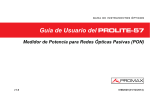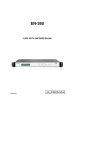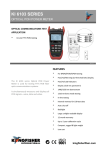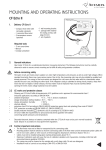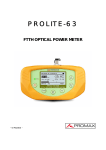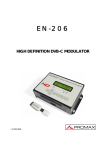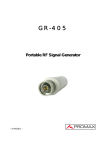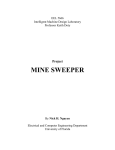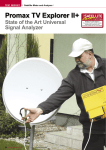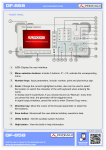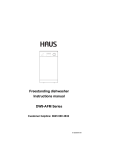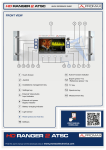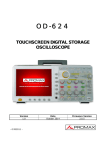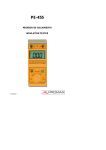Download User manual(English)
Transcript
User's Guide to the PROLITE-57 PON Power Meter v1.0 0 MI2029 (01/12/2014) PROLITE-57 1. Introduction 1.1 Summary 2008-08-22 17:00:01 1310nm ONU 1490nm OLT 1550nm VIDEO 1.2 - 4.5 -15.0 dBm Pass dBm warning dBm Fail mode Threshold dBm/dB Time REF/SEL PROLITE- 57 is a portable, high quality PON optical power meter. It is specifically designed to meet the rapid growth of FTTx market with PON (Passive Optical Network) technologies. It is capable to measure all three signals (1310nm, 1490nm and 1550nm) that carry voice, data and video, so-called t r i p l e - p l a y a p p l i c a t i o n s a l o n g a s i n g l e f i b e r. PROLITE- 57 can measure not only 1490nm and 1550nm optical signal, but also accurately detect and measure the upstream burst at 1310nm sent from an ONU while the ONU is in the idle mode. The simple operation and accurate measurement make PROLITE- 57 becomes an ideal tool for PON (suitable for APON, BPON, EPON and GPON application) installation/acceptance test to ensure that they meet required standards, and service activation and troubleshooting. 1 PROLITE-57 1.2 Main Function and Specifications Cost efficient palm size designed for field and lab testing. Support P/F measurement and normal measurement. Easy-to-use interface with large color TFT display for easy visibility and LED indicators. Simply connect-and-display the results of all three wavelengths (1310/1490/1550 nm) of PON signals with two optical ports Detect and measure the upstream burst at 1310 nm. Support APON, BPON, EPON and GPON networks. Pass, Fail and Warning indicators for easy view of signal condition. User definable threshold value (up to 10 sets) Auto power shut off. Low battery warningUSB interface. Real-time clockUnit runs either by Ni-MH battery for more than 20 hours continuously work or AC/DC adapter. 2 PROLITE-57 1.3 Specification: Connector Type SC/APC, ST/APC InGaAs Detector type Measurement Range (Continuous Datastream) 1310 nm 1490 nm -40 dBm~+10 dBm -40 dBm~+10 dBm 1550 nm -40 dBm~+20 dBm Burst measurement range -30 dBm~+10 dBm (1310 nm bursted signal) Spectral Passband 1310 nm 1490 nm 1480 nm~1550 nm 1260 nm~1360 nm Insertion Loss 1.5 dB Accuracy ±0.5 dB Linearity ±0.2 dB Display 2.8 inch TFT LCD Refresh Rate of Display Threshold 2.5 Hz 10 sets(configured via PC-based software) Auto Power-off Number of Ports 1550 nm 1539 nm~1565 nm Yes 2 ports. One for 1310 nm (ONU) and one for 1490 nm / 1550 nm (OLT) Operating Temperature Relative Humidity Power Supply -10 to +50°C 0%~95%,non-condensing 1.2V*4pcs Ni-MH AA;12V AC/DC Adapter Battery life >20 hours Dimension 190 mm*105 mm*55 mm(L*W*H) with rubber protector Net Weight 700 g 3 PROLITE-57 3 Safety Information SAFETY RULES The safety could not be assured if the instructions for use are not closely followed. The external DC charger is a Class II equipment, for safety reasons plug it to a supply line with the corresponding ground terminal . Use the mains adapter in Overvoltage Category I and Pollution Degree 1 installations. To use INDOOR . When using some of the following accessories use only the specified ones to ensure safety: Power adapter Observe all specified ratings both of supply and measurement. Use this instrument under the specified environmental conditions . The user is not allowed to carry out the following maintenance operations: Any change on the equipment must be carried out exclusively by technical staff. Follow the cleaning instructions described in the Maintenance paragraph. 4 PROLITE-57 Symbols related with safety: Discharged batteries DIRECT CURRENT ON (Supply) ALTERNATING CURRENT OFF (Supply) DIRECT AND ALTERNATING DOUBLE INSULATION (Class II protection) GROUND TERMINAL CAUTION (Risk of electric shock) PROTECTIVE CONDUCTOR CAUTION REFER TO MANUAL FRAME TERMINAL FUSE EQUIPOTENTIALITY EQUIPMENT OR COMPONENT TO BE RECYCLED 1.- When the battery power is almost out, there will be a warning of indicator keeps blinking, then please replace the batteries or plug in AC adapter to charge batteries. 2.- Please make sure that you have turned the instrument on before charge the batteries, unplug the AC adapter when the batteries are fully charged. 3.- Please make sure the batteries are well placed before charge them. 4.- To eliminate the possibility of acid leakage, please take out the batteries if the unit will not be used for a long time Specific Precautions Never look directly into optical outputs or a fiber while the equipment is on. Invisible laser beam may damage your eyes. Descriptive Examples of Over-Voltage Categories Cat I Low voltage installations isolated from themains. Cat II Portable domestic installations. Cat III Fixed domestic installations. Cat IV Industrial installations. 5 AC operation If the instrument is mainly used at one location, e.g. in a laboratory or test department, the AC adapter can be used to power it instead of batteries. There is a DC input jack on the left side of the PL-57 instrument casing into which the output cable of the AC adapter is plugged. And when the AC adapter is plugged in, the AC Indicator on the LCD will be displayed. Note: 1.- Power is supplied by the AC adapter even if battery is fitted. And the battery indicator is not displayed on the screen when AC adapter is plugged. 2.- Make sure that the operating voltage of the AC Adapter / Charger is the same as the local AC line voltage. PROLITE-57 4. Preparing for Operation Unpacking the instrument Packing material We suggest that you keep the original packing material. Using the original packing material is your guarantee of protecting the instrument during transit. Checking the package contents The standard accessories of PROLITE-57 are as follows: Main unit Carrying Case User's Guide 3 Ferrules Case strap 4*Ni-MH Batteries CD(software) 2 SC & ST adaptors USB-USB mini cable AC Adapter Checking for damage in transit After unpacking the instrument, check to see whether it was damaged in transit. This is particularly likely if the outer casing is clearly damaged. If there is damage, do not attempt to operate the instrument or to repair it without authorization. Doing so can cause further damage and you may lose your warranty qualification. 6 PROLITE-57 5. Operation 5.1 Layout ONU Video/OLT The front panel is divided in two parts: 2008-08-22 17:00:01 1310nm Part I – LCD Display ONU 1490nm OLT Part II - Keypad 1550nm VIDEO The tester shows test result on LCD screen, and in the meanwhile indicates different status in part 2 by LED. Tester connector types: SC/APC, ST/APC 7 1.2 - 4.5 -15.0 dBm Pass Part 1 dBm warning dBm Fail mode Threshold dBm/dB Time REF/SEL Part 2 P ROLITE - 57 5.2 Key’s Functions Power Switch – Press the key to Power On the unit. While the unit is in the state of power on, if pressing down the key and release quickly (less than 2 seconds), the unit will switch to auto power off; if pressing down the key for longer than 2 seconds, the unit will shut down. If the unit is in threshold setup, time setup and backlit setup menu, the key becomes ESC key to exit the menu. Mode Key – test mode. It is used to switch the test mode - P/F test mode and normal test mode. When the unit is in time setup, threshold setup and backlit menu, the key is used to increase value. Threshold – It is used to set threshold. Pressing it down for more than 2 seconds enters threshold setup menu. In threshold setup menu, press and release the key quickly (less than 2 seconds) to switch wavelength. In time setup menu, this key functions as <left> arrow key. dBm/dB/Time – unit switching key. Press and release the key quickly (less than 2 seconds) to switch unit between dB and dBm; pressing the key down for more than 2 seconds enters to time setup menu. In time setup menu, threshold setup and backlit setup menu, the key is used to decrease value. REF/SEL – It is used for reference value setup and selection. If pressing it down for more than 2 seconds, the instrument will take current light intensity as reference to do measurement. If pressing and release the key quickly (less than 2 seconds), then the key will function as <right> arrow key. 8 P ROLITE - 57 5.3 Definitions LEDs Not only the instrument will display measured optical power value on LCD screen, but also under P/F test mode its three LED indicators will function with following meanings: The three LED indicators represent upstream 1310 nm (ONU), downstream 1490 nm (OLT) and 1550 nm (Video) respectively. The RED color indicates Fail, ORANGE color is Warning and GREEN color means Pass. Thresholds The definitions for the three states (Fail, Warning and Pass) are described as below: If assuming the instrument’s measuring upper limit as Limit1 and lower limit as Limit2 , the “Pass” threshold value in instrument’s internal setup are Threshold1 , Threshold2 as Warning threshold and Threshold3 as Fail threshold, also Limit2 < Threshold3 < Threshold2 < Threshold1 < Limit1 . P value represents measured optical power, then: 1.If P < Limit2 , means the power is Low , the LED will indicate in RED ; 2.If Limit2 < P < Threshold3, means Fail , the LED will indicate in RED ; 3.If Threshold3 < P < Threshold2 , means Warning , the LED will indicate in ORANGE ; 4.If Threshold2 < P < Threshold1 , means Pass , the LED will indicate in GREEN ; 5.If Threshold1 < P < Limit1 , means Fail , the LED will indicate in RED ; 6.If P > Limit1 , means the power is High, the LED will indicate in RED . 9 P ROLITE - 57 5.4 Quick Operation 1. Connect the instrument to the optical link under test. 2. Press Power On key to turn on the instrument. 3. Pressing down Threshold key and REF/SEL key at same time enters to Backlit setup menu. Using ▲ and ▼ keys to adjust backlit to a suitable brightness then press Power key again to save the backlit setup and exit Backlit setup menu. 4. Pressing Time key for more than 2 seconds enters to time setup menu. Using ▲ , ▼ , ◄, ► and REF/SEL keys to setup time. After the setup, press Power key (less than 2 sec) to save the setting and exit. 5. Pressing Threshold key for more than 2 seconds enters to threshold setup menu. Select one group of threshold from the preset list and press Power key (less than 2 sec) to exit. 6. Press Mode key to select a test mode, and then the instrument will execute the test automatically and display the test results on the LCD screen. 7. Power Off. After completing the test , pressing Power key for more than 2 seconds to shut down the instrument. 10 P ROLITE - 57 5.5 Detail Operation 5.5.1 Powering On the Instrument Press the Power key to turn on the instrument. It will automatically go to test menu. In test menu, press Power key and release quickly (less than 2 seconds) to activate or deactivate Auto shut down function. The auto shut down function means the instrument will shut down automatically if the instrument has not been operated for a certain period of time. The time period can be set. The default is 10 min. 11 P ROLITE - 57 5.5.2 Test mode switch: In the test menu, press Mode to switch between normal test mode and P/F test mode. 1. Normal test mode Normal test mode means do not setup threshold value but display optical power directly. In this mode, the LED indicators will not light. The results are displayed in two units: dB and dBm using dB/dBm key to switch. See Fig. 1. Auto off Unit dBm is to display the actual power Unit dB is to display a power value relative to reference value. In this mode, reference value needs to be preset correctly. 2. P/F test mode P/F test mode means the measured light power comparing to preset threshold value to determine if the measured light power meets user’s requirement or not. LCD will display the optical power and current state. The LED indicators below the LCD display will also change color to match the current state of measured light. This test mode is very useful in some special cases required. See Fig. 2. 12 Fig.1 Normal Test Mode Menu (dB) Auto off Fig.2 P/F Test Mode Menu P ROLITE - 57 5.5.3 Threshold Setup The user can setup the value. The steps are as following: In the test menu, pressing Threshold key for more than 2 seconds enters to threshold setup menu – see Fig. 3 In this menu, left side displays wavelength and right side displays threshold value. Top line indicates system information (date & time) and bottom line indicates the information of threshold including threshold symbol, threshold number and name. In this menu, press and release Threshold key quickly (less than 2 seconds) to switch the wavelength among 1310 nm, 1490 nm and 1550 nm. Press ▲ ( Mode ) key to view previous record, ▼ ( dBm/dB ) key to view next record, REF/SEL key to validate the current threshold value. After above operation, all P/F mode test results will base on this threshold value. Note: The threshold value can only be preset by PC software. See PC software section for detail. After finishing the setup, press Power key (less than 2 sec) to exit the setup menu. 13 USING Threshold 01 Telecom Fig.3 Threshold Setup Menu P ROLITE - 57 5.5.4 Time Setup Pressing Time key for more than 2 seconds enters to time setup menu, see Fig. 4. Time Setup 08-10-25 15:02:03 Yes Fig.4 Time Setup Menu In the time setup menu, the Threshold key becomes <left> arrow key and REF/SEL key becomes <right> arrow key - using them to move cursor. When cursor moves to a number, the user can use ▲ ( Mode ) key to increase value and ▼ ( dBm/dB ) to decrease value. When cursor moves to “Yes” and press REF/SEL key for more than 2 seconds, the “Yes” will flash, means the instrument accepts the time change. During the time setup, the user can press Power key (less than 2 sec) to exit time menu and back to test menu, then the system time setup remains unchanged. 14 P ROLITE - 57 5.5.5 Unit Switch When the instrument is in normal test mode, pressing dBm/dB can switch unit between dBm and dB. Here, the unit dBm is the actual power and unit dB is a power value relative to reference value. Refer to next section about “Reference value setup”. When the instrument is in the P/F test mode, pressing dBm/dB key will automatically exit P/F test mode and switch to normal test mode. Its unit will be in dB. 15 P ROLITE - 57 5.5.6 Reference Value Setup In the test menu, press REF/SEL key for more than 2 seconds, then the LCD will display REF in red (see Fig. 5). This means the instrument choose the current light power as reference value. The test results afterward are the values after comparing to this reference value. Now, the unit will be in dB and LED below LCD display will not light. REF Auto off Fig.5 REF Value Setup Menu In the test menu, press and release REF/SEL key quickly (less than 2 seconds), then current reference value will appear on LCD display. See Fig. 6. dBm Ref dBm Ref dBm Ref Auto off Fig.6 View REF Value Menu 16 P ROLITE - 57 5.5.7 Backlit Setup Pressing Threshold and REF/SEL keys at same time enters to backlit setup menu. See Fig. 7. Fig.7 Backlit Setup Menu In this menu, press ▲ ( Mode ) key to brighten the backlit and ▼ ( dBm/dB ) key to weaken the backlit. After completing the setup, press Power key (less than 2 sec) to save the setting, exit and back to the test menu. 17 P ROLITE - 57 5.5.8 Description of Memory Record Function Description of Interface: At the main interface, it shows the current recording number on the left bottom of the page: Displaying : num : xxxx(xxxx means the current recording number, the maximum number up to 1000 pieces ). Low m Low Low m num:0024 Fig.8 As you may refer to the picture 8,it means there are 24 pieces of test recording inside. Press the "mode" button for longer than 3 seconds to save the current testing value, as you may refer to the picture 9, the recording number automatically adds 1 when the interfaces shows "Save". SAVE Fig.9 18 m Auto off P ROLITE - 57 At the " record view " interface(refer to picture 10), the characters on top of horizon line are "total number of recording" and "wavelength"(from left to right). The characters under horizon line are "the number of recording" and the optical power value in accordance to the corresponding wavelengths On the bottom of the page you may see the main menu 3 1: 2: 3: 1310 low low low 1490 low low low Esc Description of button 1550 low low low X RST Fig.10 Simultaneously press "Mode" and "Threshold" to enter the "record view" interface,press the " shortly to exit it, refer to picture 10 for this interface. " At the "record view" interface,you may see the main menu on the bottom of the page,they are (from left to right): ESC X RST There is an underline when you selected the menu ( the "ESC" has been chosen in picture 10),press " Threshold " shortly to move the underline from left to right , after the underline moved to your ideal menu,press " REF/SEL " shortly to execute it. 19 P ROLITE - 57 Description of every individual menu: : Page up to the last 10 recording : Page down to the next 10 recording : Page up to the last 100 recording : Page down to the next 100 recording ESC : Exit the "record view" interface ( same as press " ") X: Select one or more than one recording to delete RST : Reset the recording memory,this operation is not reversible and it'll take 5 seconds to complete with power supply can not be disconnected,otherwise it may damage the chip of tester. At the "record view" interface,press " mode " button to move "X" upward one step,press " dBm/dB " button to move "X" downward one step. In picture 10,the interfaces explains that there are totally 3 testing result 25 1310 1550 1490 inside," low " means the saving power value is lower than the value from 13: high high high 14: high high high 15: high high high threshold setting.In picture 11, " high " means the saving power value is higher high 16: high high high 17: high high than the value from threshold setting. The digital means the power value of 18: high high high 19: high high high corresponding wavelength. 20: high high high Esc Fig.11 20 X RST PROLITE-57 6. Remarks 1. When battery power is not enough, the battery indicator will flash. Please immediately use the attached AC/DC adapter or charge the instrument/battery. 2. While charging, the instrument does not allow the user to power off. If pressing Power Off key, the charger head will flash. After the battery gauge shows “full”, means the battery is fully charged, remove the charger. 3. Before charging the instrument, please make sure the rechargeable battery pack is installed. 4. If do not use the instrument for long time, please remove the battery pack to avoid battery descompotion. 5. Due to existence of strong interference in some working environment, sometime short lines or disorder may appear on LCD screen, this is normal and not going to affect the instrument. The display will back to normal if reboot the unit or switch menu to refresh the display. 21 PROLITE-57 7. Advice: 1) Please use the dust-proof cap to secure the connector to be scratched or contaminated everytime when the product is not in operation. 2) Please always stay the optical connectors away from oil, dirt and other contamination to ensure the proper operation, 3) Always be careful when you are intend to plug in and pull out the connectors because optical interface is extremely sensitive. 22 PROMAX ELECTRONICA, S. L. Francesc Moragas, 71-75 08907 L’HOSPITALET DE LLOBREGAT (Barcelona) SPAIN Tel.: 93 184 77 00 * Tel. Intl.: (+34) 93 184 77 02 Fax: 93 338 11 26 * Fax Intl.: (+34) 93 338 11 26 http://www.promaxelectronics.com e-mail: [email protected]
























